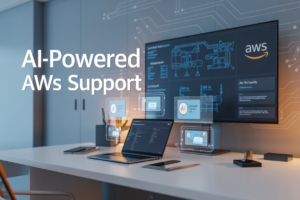Are you tired of wrestling with complex backend infrastructure for your web and mobile apps? 🤔 Enter AWS Amplify Gen 2 – a game-changing solution that’s revolutionizing the way developers build serverless applications. With its powerful features and streamlined workflow, Amplify Gen 2 is turning heads in the tech world.
Imagine creating robust, scalable apps without the headache of managing servers or worrying about infrastructure. That’s the promise of Amplify Gen 2. Whether you’re a seasoned developer or just starting out, this innovative platform offers a simpler, faster way to bring your ideas to life. But how exactly does it work, and what can it do for your projects?
In this comprehensive guide, we’ll dive deep into the world of AWS Amplify Gen 2. From understanding its core concepts to deploying your first serverless app, we’ll cover everything you need to know. Get ready to explore how to set up your development environment, build web and mobile apps, enhance functionality, and scale your creations with ease. Let’s embark on this exciting journey to unlock the full potential of serverless development! 🚀
Understanding AWS Amplify Gen 2
Key features and improvements
AWS Amplify Gen 2 brings a host of new features and improvements that streamline serverless development. Here are some key highlights:
- Simplified CLI: The new Amplify CLI offers a more intuitive command structure, reducing complexity and improving developer productivity.
- Enhanced TypeScript support: Gen 2 provides better TypeScript integration, enabling stronger type checking and improved code quality.
- Modular architecture: The new modular design allows developers to use only the components they need, reducing bundle sizes and improving performance.
| Feature | Gen 1 | Gen 2 |
|---|---|---|
| CLI Structure | Complex | Simplified |
| TypeScript Support | Limited | Enhanced |
| Architecture | Monolithic | Modular |
| Bundle Size | Larger | Optimized |
Benefits for serverless development
Amplify Gen 2 offers several advantages for serverless development:
- Faster development cycles: With improved tooling and streamlined workflows, developers can build and deploy serverless applications more quickly.
- Reduced complexity: The simplified architecture and improved documentation make it easier for developers to understand and implement serverless solutions.
- Better scalability: Gen 2’s optimized resource management allows for more efficient scaling of serverless applications.
Comparison with Gen 1
While Gen 1 laid the foundation, Gen 2 takes serverless development to the next level:
- Performance: Gen 2 offers improved performance through optimized code generation and more efficient resource utilization.
- Developer experience: The new version provides a more intuitive and consistent developer experience across different AWS services.
- Integration: Gen 2 offers tighter integration with other AWS services, enabling more powerful and flexible serverless architectures.
Now that we’ve explored the key features and benefits of AWS Amplify Gen 2, let’s move on to setting up your development environment for building serverless applications.
Setting Up Your Development Environment
Installing necessary tools
To begin your journey with AWS Amplify Gen 2, you’ll need to set up your development environment with the right tools. Here’s a list of essential tools you’ll need to install:
- Node.js (v14.x or later)
- npm (Node Package Manager)
- AWS CLI (Command Line Interface)
- Amplify CLI
To streamline the installation process, follow these steps:
- Download and install Node.js from the official website
- Verify the installation by running
node -vandnpm -vin your terminal - Install AWS CLI using the appropriate method for your operating system
- Install Amplify CLI globally using npm:
npm install -g @aws-amplify/cli
| Tool | Purpose | Installation Command |
|---|---|---|
| Node.js | JavaScript runtime | Download from nodejs.org |
| npm | Package manager | Comes with Node.js |
| AWS CLI | Interact with AWS services | Varies by OS |
| Amplify CLI | Manage Amplify projects | npm install -g @aws-amplify/cli |
Configuring AWS credentials
Before you can start using AWS Amplify Gen 2, you need to configure your AWS credentials. This step is crucial for authenticating your requests to AWS services. Here’s how to set it up:
- Create an IAM user in your AWS account with appropriate permissions
- Obtain the Access Key ID and Secret Access Key for the IAM user
- Run
aws configurein your terminal - Enter your Access Key ID, Secret Access Key, default region, and output format when prompted
Creating a new Amplify project
Now that you have the necessary tools installed and your AWS credentials configured, you’re ready to create a new Amplify project. Follow these steps:
- Navigate to your project directory in the terminal
- Run
amplify initto initialize a new Amplify project - Follow the prompts to set up your project name, environment, and default editor
- Choose your preferred programming language and framework
Once completed, Amplify will create the necessary configuration files and set up your project structure. With your development environment now set up, you’re ready to start building your serverless web or mobile app using AWS Amplify Gen 2.
Building Serverless Web Apps with Amplify Gen 2
Creating and managing APIs
With AWS Amplify Gen 2, creating and managing APIs for your serverless web apps becomes a streamlined process. Amplify CLI provides powerful tools to set up and configure your APIs effortlessly.
To create an API, use the following command:
amplify add api
This command guides you through a series of prompts to define your API structure. Once created, you can manage your API using GraphQL or REST protocols.
API Management Features
| Feature | Description |
|---|---|
| Schema Definition | Define data models using GraphQL schema |
| Resolver Generation | Automatically generate resolvers for CRUD operations |
| Custom Resolvers | Create custom resolvers for complex operations |
| API Testing | Test APIs directly from the Amplify Console |
Implementing authentication
Authentication is crucial for securing your serverless web app. Amplify Gen 2 simplifies this process by offering pre-built UI components and easy-to-use APIs.
To add authentication to your project:
- Run
amplify add auth - Choose authentication options (e.g., email, social providers)
- Implement auth flow in your app using Amplify libraries
Handling data storage with AWS DynamoDB
Amplify Gen 2 seamlessly integrates with DynamoDB for efficient data storage. Here’s how to set it up:
- Use
amplify add storageto add DynamoDB tables - Define your data model in the GraphQL schema
- Utilize Amplify’s generated CRUD operations for data manipulation
DynamoDB offers:
- Scalable NoSQL database
- Automatic data replication
- Low-latency data access
Integrating serverless functions
Serverless functions allow you to run backend code without managing servers. With Amplify Gen 2, you can easily create and integrate Lambda functions:
- Run
amplify add function - Choose your runtime (e.g., Node.js, Python)
- Implement your function logic
- Connect functions to API routes or trigger them based on events
Now that we’ve covered the core components of building serverless web apps with Amplify Gen 2, let’s explore how to develop mobile apps using this powerful framework.
Developing Mobile Apps Using Amplify Gen 2
iOS app development with Swift
When developing iOS apps with AWS Amplify Gen 2, Swift becomes your go-to language. Amplify’s Swift SDK seamlessly integrates with your iOS project, providing a robust set of tools for cloud-native development.
Key Features for iOS Development
| Feature | Description |
|---|---|
| Authentication | Easy user sign-up, sign-in, and management |
| API Integration | GraphQL and REST API support |
| Storage | Secure file storage and retrieval |
| Analytics | User behavior tracking and insights |
To get started:
- Install the Amplify CLI
- Initialize your iOS project
- Add desired Amplify features
- Generate Swift code for backend interactions
Android app development with Kotlin
For Android developers, Amplify Gen 2 offers first-class support for Kotlin. This modern language, combined with Amplify’s powerful features, enables you to build sophisticated Android apps with ease.
Amplify Android Benefits
- Simplified backend integration
- Streamlined data synchronization
- Efficient offline capabilities
- Enhanced security features
Cross-platform development with React Native
React Native developers can leverage Amplify Gen 2 to create cross-platform apps efficiently. This approach allows you to maintain a single codebase while targeting both iOS and Android platforms.
Key advantages include:
- Rapid development cycles
- Consistent user experience across platforms
- Access to native device features
- Simplified backend management
Leveraging mobile-specific features
Amplify Gen 2 enables developers to take full advantage of mobile-specific features, enhancing the user experience and app functionality.
| Feature | Implementation |
|---|---|
| Push Notifications | Amplify Notifications API |
| Geolocation | Amplify Geo API |
| Device Sensors | Platform-specific SDKs |
| Offline Data Sync | Amplify DataStore |
By integrating these features, you can create rich, responsive mobile applications that fully utilize device capabilities while benefiting from Amplify’s serverless backend infrastructure.
Enhancing App Functionality
Implementing real-time data synchronization
Real-time data synchronization is crucial for modern web and mobile apps. With AWS Amplify Gen 2, you can easily implement this feature using AWS AppSync and GraphQL subscriptions.
-
Set up AppSync API:
- Create a GraphQL schema
- Define subscription types
- Configure resolvers
-
Implement client-side subscriptions:
- Use Amplify’s API category
- Subscribe to real-time updates
Here’s a simple example of implementing a subscription:
import { generateClient } from 'aws-amplify/api';
const client = generateClient();
const subscription = client.graphql({
query: onCreateTodo,
variables: { owner: 'userId' }
}).subscribe({
next: ({ data }) => {
console.log('New todo:', data.onCreateTodo);
},
error: (error) => console.error(error)
});
Adding push notifications
Push notifications are essential for engaging users and delivering timely updates. Amplify Gen 2 simplifies this process using Amazon Pinpoint.
| Step | Description |
|---|---|
| 1 | Configure Pinpoint in your Amplify project |
| 2 | Set up platform-specific push services (FCM, APNS) |
| 3 | Implement client-side notification handling |
| 4 | Create and send notifications using Pinpoint API |
Integrating analytics
Analytics provide valuable insights into user behavior and app performance. Amplify Gen 2 offers seamless integration with Amazon Pinpoint for analytics.
-
Enable analytics in your Amplify project
-
Implement event tracking:
- Custom events
- Screen views
- User attributes
-
Analyze data using Pinpoint console or custom queries
Implementing machine learning capabilities
AWS Amplify Gen 2 allows you to easily add AI/ML capabilities to your app using Amazon SageMaker and other AWS AI services.
- Text analysis: Sentiment analysis, entity recognition
- Image and video analysis: Object detection, facial recognition
- Natural language processing: Language translation, text-to-speech
Implement these features using Amplify’s Predictions category, which provides a high-level interface for AI/ML services.
Now that we’ve enhanced our app’s functionality, let’s explore how to deploy and scale our application effectively.
Deployment and Scaling
Continuous integration and deployment
Amplify Gen 2 streamlines the CI/CD process, ensuring your serverless applications are always up-to-date. By leveraging AWS CodePipeline and CodeBuild, you can automate your deployment workflow:
- Set up a Git repository
- Configure Amplify CLI for CI/CD
- Define build specifications
- Implement automated testing
| CI/CD Step | Description |
|---|---|
| Source Control | Connect to GitHub, GitLab, or BitBucket |
| Build | Use Amplify CLI to build and test your app |
| Deploy | Automatically deploy to Amplify Hosting |
Monitoring and debugging
Effective monitoring is crucial for maintaining serverless applications. Amplify Gen 2 integrates seamlessly with AWS CloudWatch, providing:
- Real-time log analysis
- Custom metrics and alarms
- Error tracking and notifications
Use the Amplify Console to visualize your app’s performance and quickly identify issues.
Optimizing performance
To enhance your serverless app’s performance:
- Implement caching strategies
- Optimize database queries
- Utilize AWS Lambda power tuning
- Leverage content delivery networks (CDNs)
Scaling your serverless application
Amplify Gen 2 excels in auto-scaling your serverless apps. Key scaling features include:
- Automatic scaling of AWS Lambda functions
- DynamoDB on-demand capacity
- AppSync connection scaling
By leveraging these capabilities, your application can handle varying loads without manual intervention. As we move forward, it’s essential to apply these deployment and scaling strategies to ensure your serverless application remains robust and efficient.
Best Practices and Tips
Security considerations
When working with AWS Amplify Gen 2, security should be a top priority. Implement the following best practices:
- Use strong authentication mechanisms, such as Multi-Factor Authentication (MFA)
- Encrypt data at rest and in transit using AWS Key Management Service (KMS)
- Implement fine-grained access controls with AWS Identity and Access Management (IAM)
- Regularly update and patch your dependencies
Code organization and reusability
Proper code organization enhances maintainability and scalability:
- Utilize modular architecture to separate concerns
- Implement reusable components for common functionalities
- Follow consistent naming conventions and coding standards
- Leverage Amplify’s built-in libraries and APIs for efficient development
Testing strategies
Robust testing ensures app reliability and performance:
- Implement unit tests for individual components
- Conduct integration tests to verify interactions between services
- Perform end-to-end testing to simulate real-world scenarios
- Utilize Amplify’s testing tools and frameworks for comprehensive coverage
| Testing Type | Purpose | Tools |
|---|---|---|
| Unit | Test individual components | Jest, Mocha |
| Integration | Verify service interactions | Cypress, Selenium |
| End-to-End | Simulate user scenarios | Amplify Console, AWS Device Farm |
Cost optimization techniques
Optimize your AWS costs while maintaining performance:
- Use AWS Lambda for serverless compute to reduce idle time costs
- Implement caching strategies with Amazon CloudFront
- Leverage auto-scaling features to match resource allocation with demand
- Monitor and analyze usage patterns to identify cost-saving opportunities
By following these best practices and tips, you’ll be well-equipped to build secure, efficient, and cost-effective serverless applications using AWS Amplify Gen 2. Remember to continuously evaluate and refine your approach as your app evolves and scales.
AWS Amplify Gen 2 provides developers with a powerful toolkit for building serverless web and mobile applications. From setting up your development environment to deploying and scaling your apps, Amplify Gen 2 streamlines the entire process. Its robust features enable you to create sophisticated applications with ease, enhancing functionality and improving user experiences.
As you embark on your journey with AWS Amplify Gen 2, remember to follow best practices and continuously refine your skills. Whether you’re building web or mobile apps, this innovative platform offers the flexibility and scalability needed to bring your ideas to life. Embrace the serverless revolution and leverage AWS Amplify Gen 2 to create cutting-edge applications that can grow with your business needs.




















